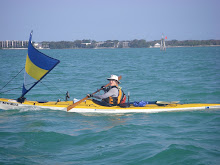 FliesWithKiwiBird and I first visited North Carolina for a fortnight’s summer holiday in 2004. (Little did we know that just over a year later we would be moving there, lock, stock and kayak from San Diego and living, it seems, somewhat permanently.) On that holiday, we made a visit to the state’s Outer Banks. From Hatteras Island we hopped aboard a small water taxi and shot across Pamlico Sound. Dropped off on the inside shore of Shackelford Island, we were left free to wander for a good few hours.
FliesWithKiwiBird and I first visited North Carolina for a fortnight’s summer holiday in 2004. (Little did we know that just over a year later we would be moving there, lock, stock and kayak from San Diego and living, it seems, somewhat permanently.) On that holiday, we made a visit to the state’s Outer Banks. From Hatteras Island we hopped aboard a small water taxi and shot across Pamlico Sound. Dropped off on the inside shore of Shackelford Island, we were left free to wander for a good few hours. I remember being astounded by the warmth of the Atlantic Ocean – in which I just had to skinny dip – the magnificent unspoiled dunes, wild horses, and the shells we gathered as we wandered.
And then a treasure find of all treasures. On the way back to our pick-up point, I found a large, prehistoric-looking, brown, curve-backed shell creature with a long pointy tail. It was obviously just the shell, as no body resided beneath. I’d never seen anything like it in all my life! Clutching it to me, insistent that it come back with us on the plane, I asked our water taxi captain what on earth it was. “‘Orseshoe crab,” he smiled. “As old as the ‘ills, and ‘undreds of ‘em ‘round ‘ere. Though that’s a ‘tic’ly big ‘un.” And back it did go home with me.
Now that I’ve kayaked the shallow warm waters of Pamlico Sound where they congregate like mussels on a rock, and wandered Shackelford’s beach many a time, I’ve found lots of dead horseshoe crab shells, of all sizes (but none as big as my first treasure). And I’ve sometimes found them alive, in the water’s shallows, trying to upright themselves in the surf – always glad to tip them over with my toes and help them on their way again.
So a week or so ago, I was all ears when National Geographic News reported that a newfound fossil species of horseshoe crab (left photo above) dates back at least 455 million years - roughly a hundred million years earlier than horseshoe crabs were previously thought to exist.
The ancient animal is remarkably similar to modern horseshoe crabs (right), according to the team that found the fossils in Manitoba, Canada.
Photograph courtesy G. Young, the Manitoba Museum (left); D. Rudkin, Royal Ontario Museum (right)
 FliesWithKiwiBird and I first visited
FliesWithKiwiBird and I first visited  FliesWithKiwiBird and I first visited
FliesWithKiwiBird and I first visited 


2 comments:
Interesting post, Kristen. Amazing how some primitive life forms persist in their ancient but successful forms. I suspect they may survive us all one day.
Nothing ever seems to change here in Canada... Maybe I'll live forever! And get downright crabby doing it!
Post a Comment